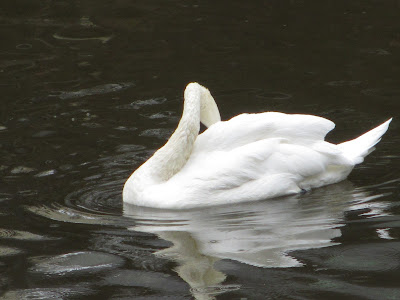Next to the trumpeter swan, the mute swan is the second largest waterfowl species.
Adult males are called cobs and average 26 pounds. Adult females are called pens and average about 20 pounds. The young swans are called cygnets. It can be distinguished from other swans by its size, white plumage,
curved neck,
and reddish-orange, black-knobbed bill.
These pictures are of swans in Amsterdam and Leyden, Netherlands.
While taking an early morning walk along the Rhine River in Breisach, Germany, I got quite close to a nesting swan sitting on a nest near the edge of the river. Unfortunately, I did not have a camera with me. On the same walk, I saw three swans flying near each other, just above the water, necks stretched forward and honking as they flew: another wonderful moment I would love to have captured on camera. Mute swans are found across Europe and western Asia.
They can be found as far south as north Africa and the Mediterranean. They have been introduced to North America, where they are deemed an invasive species, and in small numbers in Japan, New Zealand, Australia and South Africa.
In May 2013, while visiting Lake Bled, Slovenia, we saw mute swans and their cygnets. The first photo is of a cygnet and the second is of the cygnet with its parent's beak just visible, exhibiting the black knobbed bill.
In May 2013, while visiting Lake Bled, Slovenia, we saw mute swans and their cygnets. The first photo is of a cygnet and the second is of the cygnet with its parent's beak just visible, exhibiting the black knobbed bill.








No comments:
Post a Comment